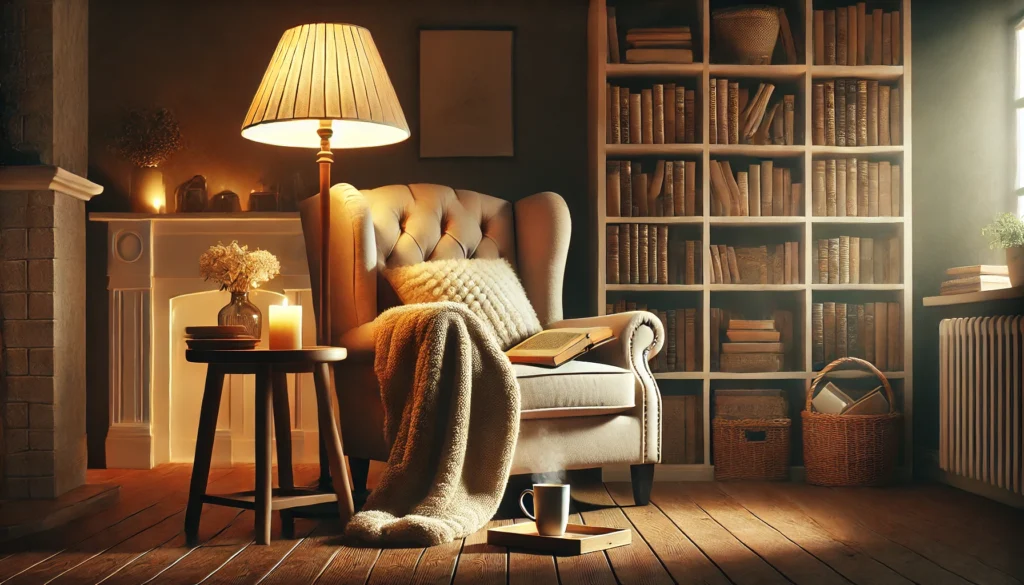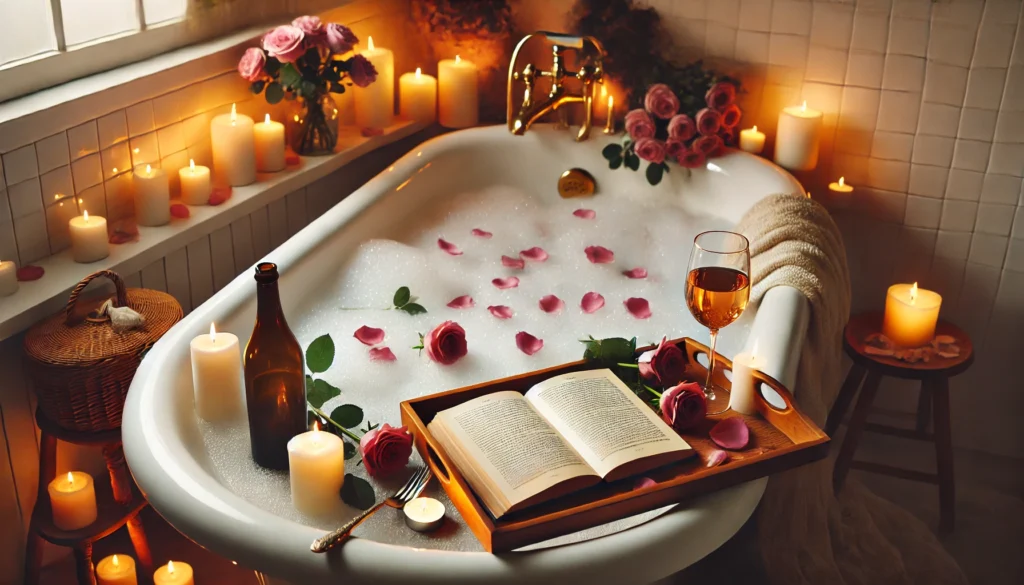Relaxation is an essential component of a healthy lifestyle, yet in our fast-paced world, it often seems elusive. Whether you’re a health and wellness coach, a science journalist, or a biohacker, the art of relaxation can enhance your mental and physical well-being. In this article, we delve into ten cozy ways to relax at home, blending scientific insights with practical advice to help you create a serene sanctuary right where you live.
You may also like: Effective Stress Management Techniques for Daily Life
1. Mindful Meditation: A Journey Within
Understanding Mindful Meditation
Mindful meditation is more than just a trend; it’s a scientifically-backed practice that reduces stress, enhances emotional health, and even improves attention. It involves focusing on the present moment without judgment, which can lead to a profound sense of peace and awareness. By regularly practicing mindfulness, individuals can cultivate a more profound connection to their thoughts and emotions, leading to greater emotional resilience and clarity.
Creating a Meditation Space
Creating a peaceful meditation space in your home can significantly enhance your practice. Choose a quiet corner where you can sit comfortably without interruptions. Consider adding elements that promote relaxation, such as a soft cushion, a calming color palette, or gentle lighting. This dedicated space can serve as a daily reminder to pause and engage in mindfulness, making it easier to incorporate meditation into your routine.
Guided Meditation Resources
For those new to meditation, guided sessions can be incredibly beneficial. Apps like Headspace or Calm offer structured programs that help you ease into meditation practice. These resources can offer various meditation styles, such as body scans, loving-kindness meditations, or breath-focused sessions, catering to different preferences and needs. With regular use, they can help establish meditation as an accessible and rewarding habit.
2. Aromatherapy: Scents That Soothe
The Science Behind Aromatherapy
Aromatherapy harnesses the power of essential oils to improve well-being. Scents like lavender, chamomile, and sandalwood are known for their calming properties. Research has shown that certain aromas can influence brain chemistry, affecting mood and stress levels. The olfactory system is directly linked to the brain’s limbic system, which is responsible for emotions, making scent a powerful tool for relaxation.
Choosing the Right Essential Oils
Selecting the right essential oils is crucial for effective aromatherapy. For relaxation, oils like lavender, bergamot, and ylang-ylang are particularly effective. Each oil has unique properties; for instance, lavender is renowned for its soothing effects, while eucalyptus is invigorating and can clear the mind. Understanding these properties can help tailor your aromatherapy experience to your specific relaxation needs.
Incorporating Aromatherapy into Daily Life
There are numerous ways to incorporate aromatherapy into your daily routine. Using a diffuser is a popular method, dispersing essential oils into the air to create a calming atmosphere. Alternatively, adding a few drops to your bath or applying diluted oils to the skin can also be effective. Regularly using aromatherapy can transform your home into a tranquil oasis, promoting relaxation and well-being.
3. Reading: Escaping Into Worlds Beyond
The Cognitive Benefits of Reading
Reading offers an escape from reality, allowing you to dive into different worlds and perspectives. Studies show that reading can reduce stress, improve mental agility, and enhance vocabulary. Engaging with complex narratives can stimulate the brain, promoting cognitive function and keeping the mind sharp. This makes reading not only a relaxing activity but also a beneficial exercise for mental health.
Creating the Perfect Reading Nook
To fully enjoy the relaxation benefits of reading, creating a cozy reading nook can be a wonderful addition to your home. Choose a comfortable chair, add a soft blanket, and ensure good lighting to prevent eye strain. Personalize the space with your favorite books, a small side table for tea or coffee, and perhaps a plant for a touch of nature. This inviting space can become your personal sanctuary for unwinding with a good book.

Exploring Various Genres
Diversity in reading material can enhance the relaxation experience. Whether it’s fiction, non-fiction, or poetry, different genres offer unique insights and pleasures. Mystery novels can provide a thrilling escape, while poetry can offer profound emotional resonance. Libraries and online platforms provide a wealth of books that cater to every interest, turning reading into a versatile and enriching hobby.
4. Yoga: Harmonizing Body and Mind
The Holistic Benefits of Yoga
Yoga combines physical postures, breathing exercises, and meditation to promote relaxation and well-being. Regular practice not only improves flexibility and strength but also enhances mental clarity and emotional balance. The integration of body and mind in yoga fosters a deeper connection to oneself, reducing stress and promoting a sense of inner peace.
Setting Up an At-Home Yoga Practice
Practicing yoga at home allows for a personalized and flexible routine. Create a dedicated space with a yoga mat, blocks, and straps to support your practice. Online classes or apps can guide you through various yoga styles, from gentle Yin Yoga to more dynamic Vinyasa flows. Establishing a regular practice time can help make yoga a consistent part of your life, providing ongoing relaxation and balance.
Exploring Different Yoga Styles
Exploring different yoga styles can add variety and keep your practice engaging. Hatha yoga focuses on foundational postures and alignment, ideal for beginners. Ashtanga offers a more vigorous practice with a set sequence of poses, while Restorative yoga emphasizes relaxation and recovery. By trying different styles, you can find the practice that best suits your relaxation and wellness goals.
5. Creative Hobbies: Unleashing Your Inner Artist
The Therapeutic Power of Creativity
Engaging in creative hobbies like painting, knitting, or crafting can be incredibly relaxing. These activities encourage mindfulness and provide a sense of accomplishment. Research shows that creativity can improve mental health by reducing symptoms of depression and anxiety. The act of creating something tangible can be deeply satisfying, offering a break from the digital world and fostering a sense of presence.
Setting Up a Creative Space
Creating a dedicated space for your creative hobbies can enhance the relaxation experience. Organize your materials in a way that inspires you, whether it’s a vibrant palette of paints or an array of colorful yarns. Ensure the space is well-lit and comfortable, allowing you to focus entirely on your creative process. This setup can serve as a haven where you can retreat and let your creativity flow.
Exploring Different Creative Outlets
Exploring various creative outlets can help you discover new passions and keep the experience fresh. From sketching and sculpting to photography and writing, each form of creativity offers unique ways to express yourself. Trying new activities can also spark inspiration and lead to unexpected discoveries. Embrace the freedom to experiment and find what truly brings you joy and relaxation.
6. Gardening: Cultivating Calm
The Mental Health Benefits of Gardening
Gardening is a rewarding way to connect with nature and nurture your mental health. The act of planting and tending to a garden can reduce stress and increase feelings of well-being. Studies suggest that exposure to nature can lower cortisol levels and improve mood, making gardening a therapeutic activity. The satisfaction of watching plants grow and thrive can also foster a sense of purpose and achievement.
Designing Your Gardening Space
Whether you have a backyard or a few pots on a balcony, designing a gardening space that suits your needs is essential. Consider the types of plants you want to grow, whether they are flowers, herbs, or vegetables. Plan your layout to maximize space and ensure plants receive adequate sunlight. A thoughtfully designed space can enhance your gardening experience, making it a source of relaxation and joy.
Sustainable Gardening Practices
Incorporating sustainable practices into your gardening can enhance its positive impact on the environment and your well-being. Use organic fertilizers and pest control methods to reduce chemical exposure. Composting kitchen waste can enrich the soil and reduce waste. By adopting eco-friendly practices, you can create a garden that not only benefits your mental health but also contributes to environmental conservation.
7. Listening to Music: The Universal Language
The Psychological Impact of Music
Music has a profound impact on our emotions and can be a powerful tool for relaxation. Studies indicate that listening to soothing music can lower blood pressure, heart rate, and anxiety levels. Music can evoke powerful memories and emotions, making it an effective way to process feelings and enhance mood. It can serve as both an escape and a form of emotional expression.

Curating Your Relaxation Playlist
Creating a playlist of your favorite relaxing tunes can enhance your music listening experience. Consider including a variety of genres, from classical and jazz to ambient sounds and nature recordings. Tailor your playlist to your mood and relaxation needs, whether you seek to unwind after a stressful day or set a calming tone for your morning routine. A well-curated playlist can become a valuable tool for managing stress and promoting relaxation.
Exploring Music as a Mindful Practice
Listening to music mindfully can deepen its relaxing effects. Focus on the melodies, lyrics, and rhythms, allowing yourself to be fully present in the experience. This practice can enhance your appreciation for music and promote mindfulness, helping you stay grounded in the present moment. By incorporating mindful listening into your routine, you can transform music into a powerful relaxation tool.
8. Cooking: Nourishing the Body and Soul
The Mindful Art of Cooking
Cooking can be a meditative experience, allowing you to focus on the task at hand and enjoy the sensory pleasures of preparing a meal. The process of chopping, stirring, and seasoning can become a form of mindfulness, where you engage fully with each step. This focus can reduce stress and provide a sense of accomplishment as you create something nourishing and delicious.
Experimenting with New Recipes
Experimenting with new recipes can add excitement to your cooking routine. Trying different cuisines or techniques can expand your culinary skills and introduce new flavors to your diet. This exploration can be both satisfying and relaxing, as it encourages creativity and offers a break from routine. Sharing these new creations with loved ones can also foster connection and joy.
Creating a Relaxing Cooking Environment
The environment in which you cook can significantly impact the relaxation experience. Keep your kitchen organized and clutter-free to reduce stress and enhance efficiency. Play soft music or light a scented candle to create a calming atmosphere. By transforming your kitchen into a welcoming space, you can make cooking a more enjoyable and stress-free activity.
9. Bath Rituals: Soaking Away Stress
The Benefits of Warm Baths
A warm bath is a classic way to unwind and soothe tired muscles. Research suggests that warm baths can improve mood, reduce stress, and promote better sleep. The heat helps relax muscles, while the buoyancy of water can alleviate tension and pain. This makes baths an effective method for both physical and mental relaxation, serving as a perfect end-of-day ritual.
Enhancing Your Bath Experience
Enhance your bath time by adding Epsom salts, essential oils, or bath bombs for an extra layer of relaxation. Epsom salts can soothe sore muscles, while essential oils like lavender can promote relaxation. Consider dimming the lights or using candles to create a tranquil atmosphere. By personalizing your bath ritual, you can create a spa-like experience in the comfort of your home.
Incorporating Meditation or Music
Incorporating meditation or music into your bath routine can deepen its relaxing effects. Listen to calming music or a guided meditation while you soak, allowing yourself to fully unwind. Focusing on your breath or the sensations of the water can also enhance mindfulness. By combining these practices, you can transform your bath into a holistic relaxation experience.
10. Journaling: Reflecting and Releasing
The Therapeutic Benefits of Journaling
Journaling is a therapeutic practice that allows you to express thoughts and emotions freely. Writing about your experiences and feelings can provide clarity and help process complex emotions. This reflective practice can reduce stress, improve mood, and enhance self-awareness. By regularly journaling, individuals can gain insight into their thoughts and behaviors, promoting personal growth.
Establishing a Journaling Routine
To reap the benefits of journaling, establishing a regular routine is key. Set aside time each day or week to jot down your reflections, goals, or gratitude entries. Choose a comfortable space and consider using a journal that inspires you. Consistent practice can make journaling a powerful tool for relaxation and self-discovery.

Exploring Different Journaling Techniques
Exploring different journaling techniques can keep the practice engaging and effective. Free writing allows thoughts to flow without constraints, while structured prompts can guide deeper reflection. Bullet journaling combines organization with creativity, offering a visual way to track goals and progress. By experimenting with various methods, you can find the journaling style that best supports your relaxation and personal development goals.
In conclusion, finding time to relax at home is crucial for maintaining mental and physical health. By incorporating these ten cozy practices into your routine, you can create a sanctuary that nurtures your well-being. Whether you’re seeking relaxation techniques for yourself or looking to share them with others, these activities offer a path to a more serene and fulfilling life. Embrace the art of relaxation and discover the profound benefits it can bring to your everyday existence.
Further Reading:
Relaxing Home | Create A Calm, Peaceful Environment
How to Relax: A Guide for Relaxing Close to Home
How to Create a Calm Home: 20 Tips for A Peaceful Home
Important Note: The information contained in this article is for general informational purposes only, and should not be construed as health or medical advice, nor is it intended to diagnose, prevent, treat, or cure any disease or health condition. Before embarking on any diet, fitness regimen, or program of nutritional supplementation, it is advisable to consult your healthcare professional in order to determine its safety and probable efficacy in terms of your individual state of health.
Regarding Nutritional Supplements Or Other Non-Prescription Health Products: If any nutritional supplements or other non-prescription health products are mentioned in the foregoing article, any claims or statements made about them have not been evaluated by the U.S. Food and Drug Administration, and such nutritional supplements or other health products are not intended to diagnose, treat, cure, or prevent any disease.


